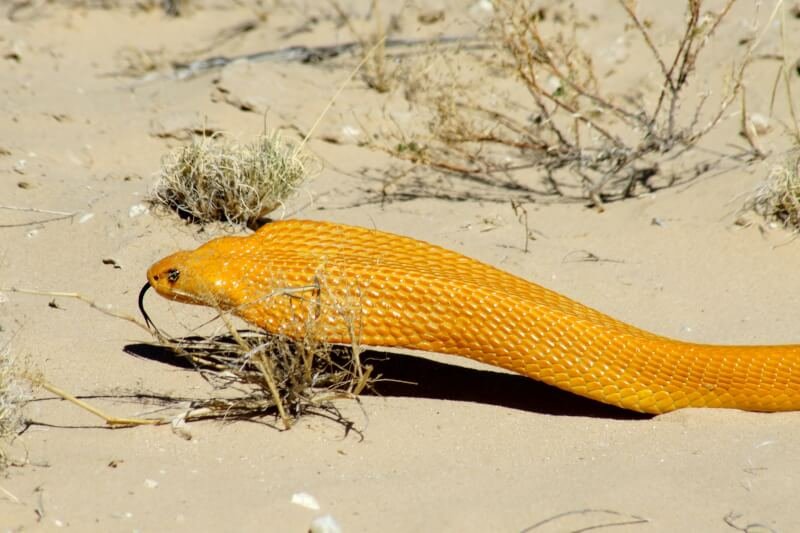You are about to embark on an exciting journey into the wondrous world of snakes. From the striking beauty of a venomous cobra to the immense strength of a python, there are countless famous snake species that captivate our imagination. Whether you’re a curious explorer or an avid snake lover, this article will uncover some of the most renowned snake species that have intrigued and fascinated humans for centuries. So fasten your seatbelt and get ready to discover the incredible diversity and awe-inspiring characteristics of these incredible creatures.
Famous Snake Species
When it comes to famous snake species, there are several that immediately come to mind. From the dangerous and venomous to the awe-inspiring and majestic, these snakes have captured the curiosity and fascination of people around the world. Let’s take a closer look at some of the most well-known snake species out there.
Cobra
The cobra is arguably one of the most iconic snake species in the world. Known for its venomous bite and hooded appearance, the cobra is a sight to behold. Physical characteristics of the cobra include a slender body, distinctive head shape, and large, menacing fangs. Cobras can be found in various parts of the world, including Africa, Asia, and the Middle East.
Cobras are notorious for their venomous bite. The venom acts as a neurotoxin, affecting the nervous system of their prey. However, it’s important to note that not all cobra species are equally venomous, with some having more potent venom than others. Despite their deadly reputation, cobras play a significant role in culture, often symbolizing power, mystique, and even deities in certain regions.

Python
Another famous snake species that cannot go unnoticed is the python. Known for their impressive size and strength, pythons are found in tropical regions across the globe. Physical characteristics of pythons include their muscular bodies, patterned scales, and heat-sensitive pits on their lips, which help them locate warm-blooded prey.
One of the most notable features of pythons is their method of killing their prey. Unlike venomous snakes, pythons rely on constriction to subdue their victims. They wrap their bodies around the prey, squeezing until the prey is no longer able to breathe. They then swallow their prey whole, thanks to their incredibly flexible jaws.
Among the various python species, some of the most popular include the Burmese python, reticulated python, and green tree python. These snakes have captivated snake enthusiasts around the world with their beautiful colors, impressive size, and unique behaviors.
Viper
Vipers are a diverse group of venomous snakes found in various parts of the world. Known for their distinctive triangular-shaped heads, hinged fangs, and venomous bite, vipers are not to be taken lightly. Their physical characteristics also include heat-sensing pits on their faces, allowing them to locate warm-blooded prey, even in the dark.
Geographically, vipers have a wide distribution, with different species found in Europe, Asia, Africa, and the Americas. Each region is home to its own unique varieties of vipers, each with its own adaptations and venom compositions. Some well-known viper species include the rattlesnake, Gaboon viper, and bushmaster.
The venomous bite of vipers is a topic of great concern due to its potential danger. Viper venom is a potent mixture of proteins and enzymes that can cause severe tissue damage, internal bleeding, and even death if left untreated. However, it’s important to remember that snakes, including vipers, play an important role in maintaining the balance of ecosystems.
Rattlesnake
When it comes to venomous snakes, the rattlesnake stands out as one of the most recognizable and feared. Found predominantly in the Americas, rattlesnakes are known for their distinct rattles on their tails, which they use as a warning system. Each time a rattlesnake sheds its skin, a new segment is added to its rattle, creating a unique sound when shaken.
Physical characteristics of rattlesnakes include a thick body, triangular-shaped head, and heat-sensing pits. Their venomous bite, delivered through their hollow fangs, contains a potent cocktail of toxins that can incapacitate their prey. While rattlesnakes are venomous, they are not naturally aggressive towards humans and will typically only strike if threatened or cornered.
Despite their venomous properties, rattlesnakes play an important role in their ecosystems. They help control rodent populations, which can have a significant impact on the overall balance of an ecosystem.
Anaconda
The anaconda holds a place of intrigue and mystery in the realm of snakes. Known for their sheer size and strength, anacondas are considered some of the largest snakes in the world. Physical characteristics of anacondas include a thick, muscular body, dark green coloration, and a powerful bite.
Anacondas are primarily found in the tropical rainforests of South America, particularly in the Amazon basin. They are semi-aquatic snakes, often thriving in swamps, marshes, and slow-moving rivers. While anacondas are not venomous, they are formidable predators, relying on their immense size and strength to overpower their prey.
There are several myths and misconceptions surrounding anacondas, with exaggerated tales about their ability to swallow humans whole. While anacondas are indeed capable of swallowing large prey, including deer and caimans, they tend to avoid confrontations with humans and prefer retreating into the water when encountering them.
Boa Constrictor
Boa constrictors are another group of formidable snakes known for their constricting technique. These snakes are found in both North, Central, and South America, with various species inhabiting different regions. Physical characteristics of boa constrictors include a muscular body covered in beautiful patterns, a triangular-shaped head, and distinctive heat-sensing pits.
Boa constrictors are skilled hunters, using their powerful bodies to coil around their prey and squeeze until it suffocates. Unlike venomous snakes that immobilize their prey through venom, boa constrictors rely solely on their muscular strength. They are nocturnal hunters and are particularly proficient at climbing trees to ambush their prey.
Threats to boa constrictors include habitat loss, illegal pet trade, and the misconception that they pose a threat to humans. In reality, these snakes are generally non-aggressive and prefer to avoid human encounters whenever possible. Educating the public about the importance of these snakes in maintaining ecological balance is crucial for their conservation.
King Cobra
The king cobra is the largest venomous snake in the world and has earned a reputation as the “king” due to both its size and deadly bite. These majestic snakes are native to the rainforests of Southeast Asia, including India, Indonesia, and the Philippines. Physical characteristics of king cobras include a long, slender body, distinctive hooded head, and intimidating size.
The venom of the king cobra is highly potent and neurotoxic, capable of incapacitating even large mammals. They are known for their aggressive behavior when threatened, often rearing up and displaying their hood to deter potential predators or threats. Despite their deadly bite, king cobras play an important role in their ecosystems, helping control rodent populations.
Threats to the survival of king cobras include habitat destruction, illegal wildlife trade, and human fear leading to unnecessary killings. Conservation efforts aimed at protecting their natural habitat and raising awareness about the importance of these snakes are critical for their survival.
Black Mamba
The black mamba is one of the deadliest snakes on the planet, known for its speed, agility, and potent venom. Native to the savannahs and rocky hills of sub-Saharan Africa, these snakes are feared by many due to their reputation for aggression and lethal bite. Physical characteristics of black mambas include a slender, elongated body, dark brown or black coloration, and a distinctive open-mouthed threat display.
Black mambas are not only fast but also highly venomous. Their venom contains a combination of neurotoxins and cardiotoxins, which can rapidly incapacitate their prey and potentially cause severe reactions in humans. Despite their deadly nature, black mambas are generally shy and prefer to avoid human encounters whenever possible.
In addition to their venomous properties, black mambas are also known for their incredible speed and agility, capable of slithering at speeds of up to 12 miles per hour. Their striking appearance and reputation in African folklore have given them a place in popular culture.
Green Tree Python
The green tree python is a beautiful and vibrant snake species found in the forests of New Guinea and surrounding islands. Known for its stunning emerald green coloration, the green tree python is a favorite among snake enthusiasts. Physical characteristics of green tree pythons include their slender body, triangular head, and heat-sensitive pits on their face.
These pythons are excellent climbers, spending most of their time coiled on tree branches, waiting for unsuspecting prey to come within striking distance. Their striking green coloration acts as excellent camouflage among the jungle foliage. They primarily feed on small mammals, birds, and reptiles, using their powerful bodies to capture and constrict their prey.
In addition to their beauty, green tree pythons are also valued for their role in the ecosystem. They help control populations of small mammals and contribute to the overall balance of their natural habitat.
Diamondback Snake
The diamondback snake, specifically the Eastern diamondback rattlesnake, holds a place of significance in North America. Found primarily in the southeastern United States, these venomous snakes are known for their distinctive diamond-shaped patterns on their bodies. Physical characteristics of diamondback snakes include a thick body, triangular-shaped head, and a rattle on their tails.
Geographically, diamondback snakes have a limited distribution, mainly occupying woodland areas, pine forests, and even coastal dune habitats. They play a crucial role in maintaining the balance of the ecosystem by preying on rodents, thereby helping to control their populations.
The venom of diamondback snakes is extremely potent and can cause severe pain, tissue damage, and in some cases, even death if left untreated. However, it’s important to remember that snakes, including diamondbacks, are generally non-aggressive and will typically only strike if threatened or provoked.
In conclusion, the world of snakes is filled with fascinating and famous species that capture our attention, whether it’s their venomous bite, incredible size, or vibrant colors. From the fearsome cobra and agile black mamba to the impressive python and majestic king cobra, each species has unique characteristics and plays a vital role in the ecosystems they inhabit. Appreciating and understanding these snakes can help us cultivate a deeper respect for their importance in nature.


